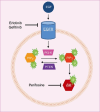Targeting glioma stem cells: a novel framework for brain tumors
- PMID: 21848914
- PMCID: PMC4021040
- DOI: 10.1111/j.1349-7006.2011.02064.x
Targeting glioma stem cells: a novel framework for brain tumors
Abstract
The past decade has seen a dramatic increase in stem cell research that focuses on glioma stem cells (GSC) and their mechanisms of action, revealing multiple potential targets for primary malignant brain tumors. Herein, we present a novel framework for considering GSC targets based on direct and indirect strategies. Direct strategies target GSC molecular pathways to overcome their resistance to radiation and chemotherapy, block their function or induce their differentiation. Indirect strategies target the microenvironment of the GSC, namely the perivascular, hypoxic and immune niches. Progress made on GSC targets is reviewed in detail and specific pathways are identified in context of the proposed framework. The potential barriers for translation to the clinical setting are also discussed. Overall, targeting GSC provides an unprecedented opportunity for revolutionary approaches to treat high-grade gliomas that continue to have a poor patient prognosis.
© 2011 Japanese Cancer Association.
Figures



Similar articles
-
Repurposing FDA approved drugs inhibiting mitochondrial function for targeting glioma-stem like cells.Biomed Pharmacother. 2021 Jan;133:111058. doi: 10.1016/j.biopha.2020.111058. Epub 2020 Dec 8. Biomed Pharmacother. 2021. PMID: 33378970 Free PMC article.
-
Glioma stem cell maintenance: the role of the microenvironment.Curr Pharm Des. 2011;17(23):2386-401. doi: 10.2174/138161211797249260. Curr Pharm Des. 2011. PMID: 21827414 Free PMC article. Review.
-
Tumor Development and Angiogenesis in Adult Brain Tumor: Glioblastoma.Mol Neurobiol. 2020 May;57(5):2461-2478. doi: 10.1007/s12035-020-01892-8. Epub 2020 Mar 9. Mol Neurobiol. 2020. PMID: 32152825 Free PMC article. Review.
-
Specific Preferences in Lineage Choice and Phenotypic Plasticity of Glioma Stem Cells Under BMP4 and Noggin Influence.Brain Pathol. 2016 Jan;26(1):43-61. doi: 10.1111/bpa.12263. Epub 2015 May 19. Brain Pathol. 2016. PMID: 25808628 Free PMC article.
-
A novel drug conjugate, NEO212, targeting proneural and mesenchymal subtypes of patient-derived glioma cancer stem cells.Cancer Lett. 2016 Feb 28;371(2):240-50. doi: 10.1016/j.canlet.2015.11.040. Epub 2015 Dec 9. Cancer Lett. 2016. PMID: 26683773
Cited by
-
Deubiquitinase USP9X deubiquitinates β-catenin and promotes high grade glioma cell growth.Oncotarget. 2016 Nov 29;7(48):79515-79525. doi: 10.18632/oncotarget.12819. Oncotarget. 2016. PMID: 27783990 Free PMC article.
-
Development of Polymer-Based Nanoformulations for Glioblastoma Brain Cancer Therapy and Diagnosis: An Update.Polymers (Basel). 2021 Nov 26;13(23):4114. doi: 10.3390/polym13234114. Polymers (Basel). 2021. PMID: 34883617 Free PMC article. Review.
-
The Transient Receptor Potential Vanilloid Type-2(TRPV2) Ion Channels in Neurogenesis andGliomagenesis: Cross-Talk between TranscriptionFactors and Signaling Molecules.Cancers (Basel). 2019 Mar 6;11(3):322. doi: 10.3390/cancers11030322. Cancers (Basel). 2019. PMID: 30845786 Free PMC article. Review.
-
BIX01294, an inhibitor of histone methyltransferase, induces autophagy-dependent differentiation of glioma stem-like cells.Sci Rep. 2016 Dec 9;6:38723. doi: 10.1038/srep38723. Sci Rep. 2016. PMID: 27934912 Free PMC article.
-
Glioma Stemlike Cells Enhance the Killing of Glioma Differentiated Cells by Cytotoxic Lymphocytes.PLoS One. 2016 Apr 13;11(4):e0153433. doi: 10.1371/journal.pone.0153433. eCollection 2016. PLoS One. 2016. PMID: 27073883 Free PMC article.
References
-
- Central Brain Tumor Registry of the United States . CBTRUS Statistical Report: Primary Brain and Central Nervous System Tumors diagnosed in the United States 2004–2006. Hinsdale, IL: CBTRUS, 2010.
-
- Stupp R, Hegi ME, Mason WP et al. Effects of radiotherapy with concomitant and adjuvant temozolomide versus radiotherapy alone on survival in glioblastoma in a randomised phase III study: 5‐year analysis of the EORTC‐NCIC trial. Lancet Oncol 2009; 10: 459–66. - PubMed
-
- Lapidot T, Sirard C, Vormoor J et al. A cell initiating human acute myeloid leukaemia after transplantation into SCID mice. Nature 1994; 367: 645–8. - PubMed
-
- Bonnet D, Dick JE. Human acute myeloid leukemia is organized as a hierarchy that originates from a primitive hematopoietic cell. Nat Med 1997; 3: 730–7. - PubMed
Publication types
MeSH terms
Substances
Grants and funding
LinkOut - more resources
Full Text Sources
Other Literature Sources
Medical
Research Materials
Miscellaneous

